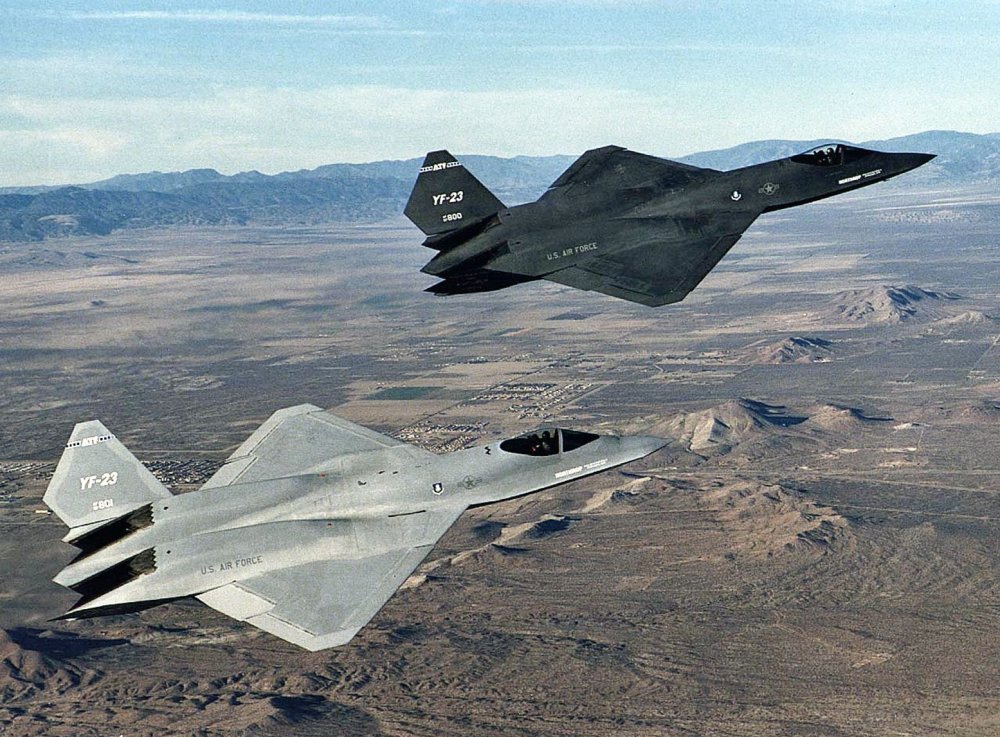
The Northrop YF-23 Stealth Fighter: The Killer Jet the Air Force Said No To
The F-22 made it obsolete.
by David AxeKey point: The YF-23 wasn't bad, but the F-22 was better.
The U.S. Air Force came very close to buying a rocket ship.
In 1991, the Air Force selected Lockheed’s YF-22 fighter over Northrop’s YF-23 as the basis for the service’s new air-superiority fighter.
That wasn’t the only major decision the Air Force made at the time. The service also selected Pratt & Whitney’s YF-119 as the engine that would power that YF-22, in the process rejecting General Electric’s YF-120.
It’s apparent 28 years later that the Air Force preferred the YF-119 because it seemed it would be cheaper and easier to develop and build. The YF-120 demonstrably was more powerful. But that power came at a cost that the flying branch decided was unacceptable.
History flows in one direction and fantastical conjecture about long-ago weapons programs can be toxic. But in 2019 as the Air Force begins considering how eventually to replace the F-22, it’s worth considering the implications of choosing cheaper and more reliable technology over riskier, pricier but potentially more powerful tech.
The Air Force in 1971 began studying requirements for a new fighter to succeed the F-15, which itself at the time was still in development, recalled Paul Metz, a former Northrop test pilot who flew the YF-23.
Metz and fellow YF-23 test pilot Jim Sandberg in 2015 spoke at length about the YF-23 in a lecture series at the Western Museum of Flight in California.
Studies continued for 10 years before the service finally approached the aerospace industry. The Air Force in 1981 asked nine companies to pitch new fighter designs. Seven responded. The Air Force in 1986 tapped Lockheed and Northrop each to build and test two prototypes. The deadline was in 1991.
Meanwhile, the Air Force tapped Pratt & Whitney and General Electric each to develop a new engine to power the two YF-22s and two YF-23s that Lockheed and Northrop were building. One of each type of demonstrator would fly with the Pratt & Whitney YF-119 while the other flew with General Electric’s YF-120.
In a sense, the Air Force planned to consider not two competing fighter designs, but four. That’s how different the two motors were. “This was a competition between two airplane designs but also two engine designs,” Sandberg said.
One key requirement was that the demonstrators be able to “supercruise” at supersonic speed without using their fuel-thirsty afterburners. In designing the YF-119, Pratt & Whitney stressed “a balance between performance, safety and reliability, maintainability and low life-cycle cost,” according to Globalsecurity.org.
General Electric, by contrast, “was focused on performance for the supercruise requirement,” David Aronstein, Michael Hirschberg and Albert Piccirillo wrote in their book Advanced Tactical Fighter to F-22 Raptor: Origins of the 21st Century Air Dominance Fighter.
During a brief but intensive flight-test program ending in early 1991, the YF-120 proved to be the more powerful of the two engines. The YF-22 and YF-23 both supercruised faster with the YF-120 than they did with the YF-119, Sandberg said.
The YF-120-powered YF-23 in particular was a veritable rocketship, supercruising faster than Mach 1.6.
But that power came at a cost. The YF-120 might be more difficult, and more expensive, to develop for mass production. When the Air Force tapped the YF-22 as the basis for its next fighter, it also selected the YF-119 as that fighter’s engine.
“The Air Force did not consider this demonstration to be a performance ‘fly-off’ but rather a demonstration of the technical and management capability needed to meet the program objectives during [development] with the least technical risk and the lowest cost," California think-tank RAND explained.
The service’s risk-aversion also helped to explain its preference for the YF-22, which many observers believed was an inferior performer compared to the YF-23. But Lockheed reportedly pitched what the Air Force considered to be a low-risk development and production process that the service hoped would minimize delays and cost overruns.
Sandberg for one called the Air Force’s preference for the lower-performing Pratt & Whitney engine “interesting.”
History seems to have validated the Air Force’s 1991 decisions. In 2019 the F-119-powered F-22 probably is the most capable fighter in the world.
If the flying branch applies the same criteria to a new fighter design to replace the F-22, it might opt for airframe and engine designs that are sophisticated … without being too sophisticated.
David Axe serves as Defense Editor of the National Interest. He is the author of the graphic novels War Fix, War Is Boring and Machete Squad. This first appeared in June 2019 and is being republished due to reader's interest.
Media: Wikipedia